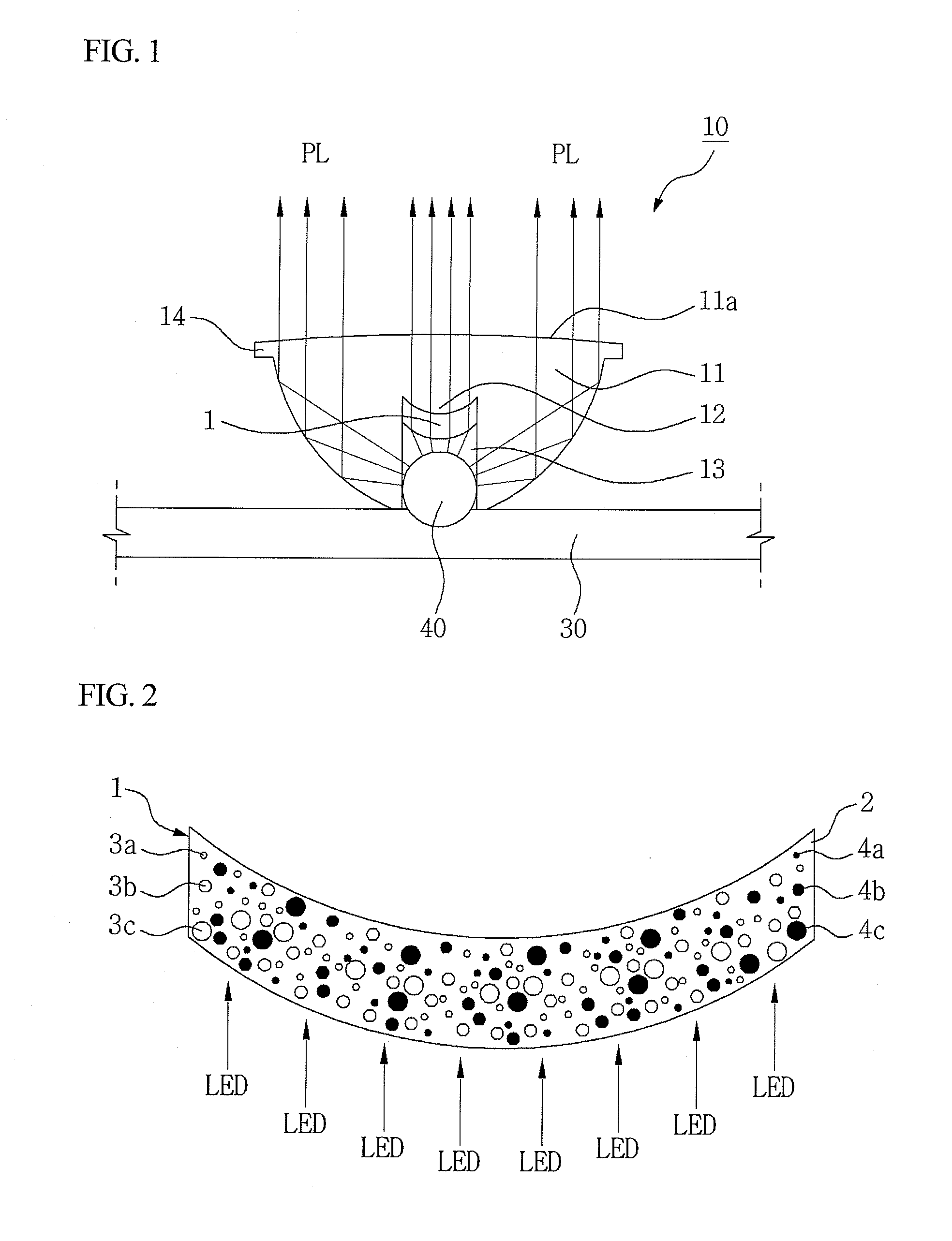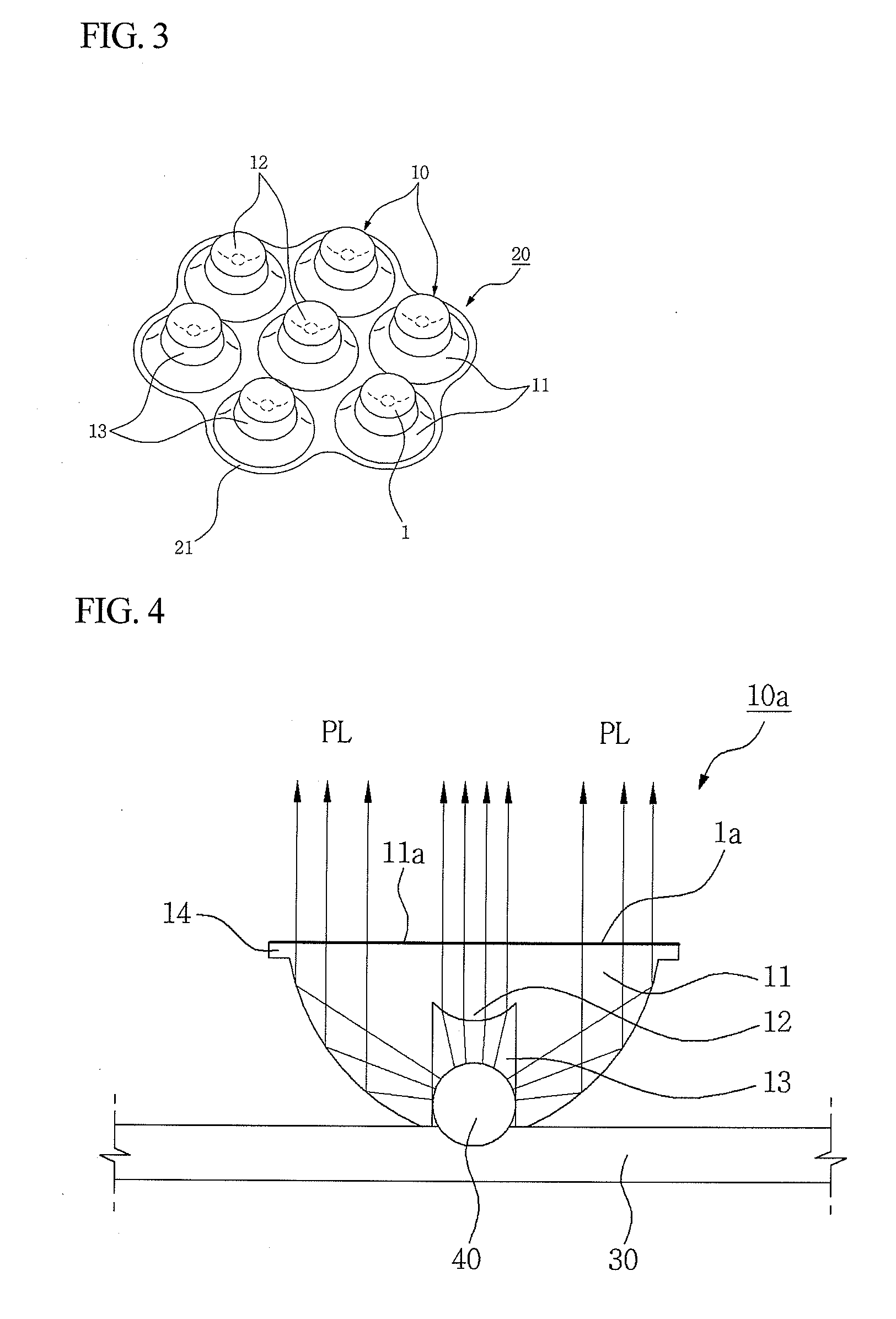LED light converting resin composition and LED member using the same
a technology of led light converting resin and resin composition, which is applied in the direction of instruments, discharge tubes luminescnet screens, lenses, etc., can solve the problems of reducing the optical characteristic and reliability of the product, requiring a relatively high manufacturing cost, and increasing the size of the product, so as to achieve simple and easy replacement of the lens, short life, and easy replacement
- Summary
- Abstract
- Description
- Claims
- Application Information
AI Technical Summary
Benefits of technology
Problems solved by technology
Method used
Image
Examples
example 1
[0113]First, an LED lens cluster made of an epoxy resin, as shown in FIG. 3, was injection-molded. Then, a LED light converting resin composition for conversion of an emitted color, including 84 wt % of a silicon resin (Dow Corning Corp., 409 HS), 14 wt % of (YGd)3A15O12: Ce as a yellow fluorescent substance, and 2 wt % of polymethylmethacrylate with an average particle diameter 2.0 μm (refractive index: 1.50, light transmittance: 91%) as a light diffuser, was double-injection molded with a thickness of 2 mm within the LED mounting portion. The molded article was integrally formed with the LED lens.
[0114]The LED lens cluster manufactured as described above was mounted to the LED lighting device provided with a blue LED, as shown in FIG. 5. As a result, a slightly yellowish white light was obtained.
example 2
[0115]An LED lens cluster was manufactured in the same manner as in Example 1, except that a LED light converting resin composition for emitted-color conversion, includes 84 wt % of a silicon resin (Dow Corning Corp., 409 HS), 13.8 wt % of (YGd)3A15O12: Ce as a yellow fluorescent substance, 2 wt % of polymethylmethacrylate with an average particle diameter 2.0 μm as a light diffuser, and 0.2 wt % of naphthalazobenzene.
[0116]The LED lens cluster manufactured as described above was mounted to the LED lighting device provided with a blue LED, as shown in FIG. 5. As a result, a yellow light was obtained due to the addition of a pigment.
example 3
[0117]An LED lens cluster was manufactured in the same manner as in Example 1, except that a LED light converting resin composition includes 83 wt % of a polymethyl pentene resin (Mitsui Kagaku Co., Ltd., Japan, heat-resistance temperature: 200° C., MTS 284), 9 wt % of Y2O2S:Eu,Gd as a red fluorescent substance, 6 wt % of ZnS:Cu,Al as a green fluorescent substance, and 2 wt % of polymethylmethacrylate with an average particle diameter 2.0 μm as a light diffuser.
[0118]The LED lens cluster manufactured as described above was mounted to the LED lighting device provided with a blue LED, as shown in FIG. 5. As a result, a natural three-wavelength white light was obtained.
PUM
 Login to View More
Login to View More Abstract
Description
Claims
Application Information
 Login to View More
Login to View More - R&D
- Intellectual Property
- Life Sciences
- Materials
- Tech Scout
- Unparalleled Data Quality
- Higher Quality Content
- 60% Fewer Hallucinations
Browse by: Latest US Patents, China's latest patents, Technical Efficacy Thesaurus, Application Domain, Technology Topic, Popular Technical Reports.
© 2025 PatSnap. All rights reserved.Legal|Privacy policy|Modern Slavery Act Transparency Statement|Sitemap|About US| Contact US: help@patsnap.com



